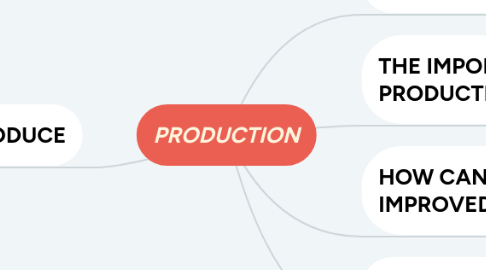
1. WHERE TO PRODUCE
1.1. Country factors
1.1.1. Political economy
1.1.1.1. Political systems
1.1.1.2. Economic Systems
1.1.1.2.1. Market economy
1.1.1.2.2. Command economy
1.1.1.2.3. Mixed economy
1.1.2. National culture
1.1.3. Factor costs
1.1.4. Location externalities
1.1.4.1. Presence of global concentrations of activities at certain locations
1.1.5. Formal and informal trade berriers
1.1.6. Transportation costs
1.1.7. Regulations affecting FDI
1.1.8. Expected future movements in exchange rate
1.2. Technology factors
1.2.1. Use to perform specific manufacturing activities can be pivotal in location decisions
1.2.2. Fixed costs
1.2.2.1. FC are high
1.2.2.1.1. Single location
1.2.2.1.2. Very few location
1.2.2.2. FC are relative low
1.2.2.2.1. Several locations
1.2.3. Minimum efficient scale (MES)
1.2.3.1. The level of output at which most plant-level scale economies are exhausted
1.2.3.2. MES is high
1.2.3.2.1. Single location
1.2.3.2.2. A limited number of locations
1.2.3.3. MES is low
1.2.3.3.1. Multiple locations
1.2.4. Flexibility of the technology
1.2.4.1. Reduced set-up times for complex equipment
1.2.4.2. Increase the utilization of individual machines
1.2.4.3. Improves quality control
1.2.4.4. Produce a wide variety of end products at a relatively low unit cost
1.2.4.4.1. Mass customization: The production of a variety of end products at a unit cost that could price be achieved only through mass production of a standard output
1.2.4.4.2. Flexible machine cells: Flexible manufacturing technology in which a grouping of various machine types, a common materials handler, and a centralized cell controller produce family of products
1.3. Production factors
1.3.1. Locating production facilities
1.3.1.1. When?
1.3.1.1.1. Concentrated production
1.3.1.1.2. Decentralize production
1.3.2. Product features
1.3.2.1. Product's value to weight ratio
1.3.2.1.1. High value-to-weight ratio
1.3.2.1.2. Low value-to-weight ratio
1.3.2.2. Universal needs
1.3.2.2.1. when products serve universal needs, the need for local responsiveness falls and concentrating manufacturing in a central location makes sense.
1.3.3. Strategic roles for production facilities
1.3.3.1. Global learning" the idea that valuable knowledge does not reside just in a firm's domestic operations, it may also be found in its foreign subsidiaries
1.3.3.2. Foreign factories can have a number of roles or designations
1.3.3.2.1. Offshore factory: a factory that is developed and set up mainly for producing
1.3.3.2.2. Source factory: a factory whose primary purpose is also to drive down costs in the global supply chain
1.3.3.2.3. Server factory: a factory that is linked into the global supply chain for a global firm to supply specific country or regional markets around the world
1.3.3.2.4. Contributor factory: a factory that serves a specific country or a world region
1.3.3.2.5. Outpost factory: a factory that can be viewed as an intelligence-gathering unit
1.3.3.2.6. Lead factory: a factory that is intended to create new process, products and technologies that can be used throughout the global firm in all parts of the world
1.3.3.3. The hidden costs of foreign locations
1.3.3.3.1. High employee turnover
1.3.3.3.2. Shoddy workmanship
1.3.3.3.3. Poor product quality
1.3.3.3.4. Low productivity
2. DEFINITION
2.1. Activities involved in creating a product
2.2. Denoted both services and manufacturing activities
3. THE IMPORTANT OF PRODUCTION
3.1. Increase quality
3.1.1. Increase productivity
3.1.2. Lower total cost
4. HOW CAN THE QUALITY BE IMPROVED
4.1. Reduces costs to improve productivity.
4.2. Using Six Sigma
4.2.1. To reduces bad products, costs, improve productivity, profits.
4.2.2. Informative for multinational firms can follow.
4.2.3. Adopted by many firms
5. MAKE OR BUY DECISION
5.1. Concerning whether to produce an item in-house ("make") or purchase it from an outside supplier ("buy")
5.2. In reality, based largely on two critical factors: cost and production capacity
5.3. Make
5.3.1. Where to purchase raw materials and component parts
5.3.2. Costs must lower (or at least not greater) than outsourcing the production in another country
5.3.3. Must have excess production capacity or capacity that is best used by home firm
5.3.4. If proprietary technology is secret and unshareable
5.3.5. Excess capacity
5.3.5.1. If quality control is important to the global firm -> Cannot be outsourced
5.3.6. Supply chain cannot be guaranteed
5.3.7. Industry globalization drivers
5.4. BUY
5.4.1. Minimal restrictions on raw materials and component parts
5.4.2. Lacks the needed expertise to make a product or component parts
5.4.3. Small volumes
5.4.4. Buying from others simplified strategically manage inventory
5.4.5. If the item made is nonessential that has little effect on the firm’s core competencies and what the customers expect in terms of uniqueness
5.4.6. If competencies reside closer to the production facility
5.4.7. If people favor some particular products or component parts

